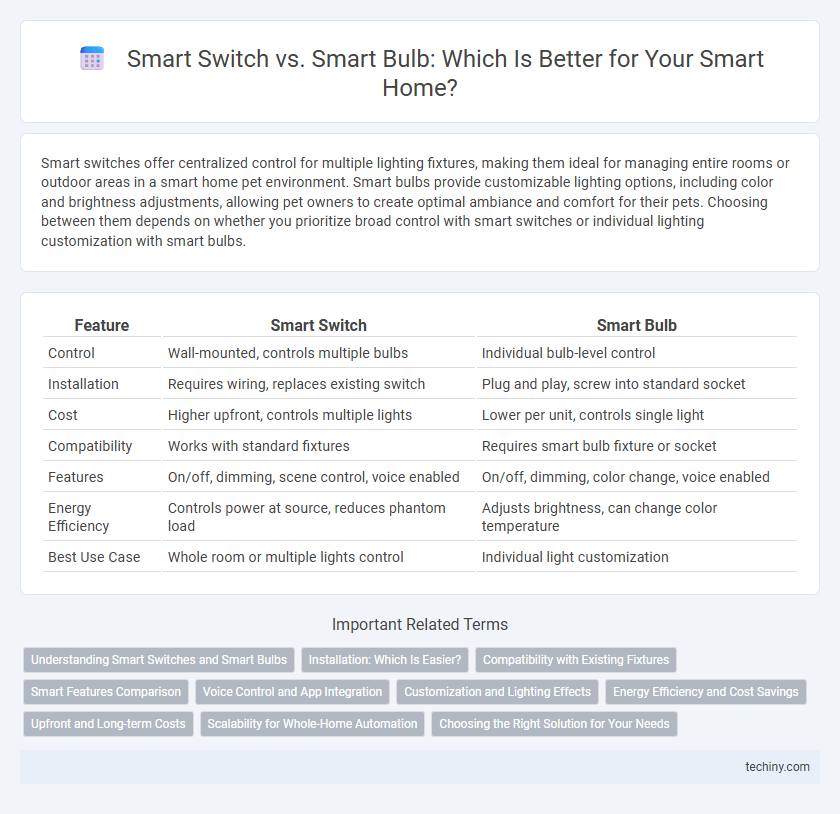Smart switches offer centralized control for multiple lighting fixtures, making them ideal for managing entire rooms or outdoor areas in a smart home pet environment. Smart bulbs provide customizable lighting options, including color and brightness adjustments, allowing pet owners to create optimal ambiance and comfort for their pets. Choosing between them depends on whether you prioritize broad control with smart switches or individual lighting customization with smart bulbs.
Table of Comparison
| Feature | Smart Switch | Smart Bulb |
|---|---|---|
| Control | Wall-mounted, controls multiple bulbs | Individual bulb-level control |
| Installation | Requires wiring, replaces existing switch | Plug and play, screw into standard socket |
| Cost | Higher upfront, controls multiple lights | Lower per unit, controls single light |
| Compatibility | Works with standard fixtures | Requires smart bulb fixture or socket |
| Features | On/off, dimming, scene control, voice enabled | On/off, dimming, color change, voice enabled |
| Energy Efficiency | Controls power at source, reduces phantom load | Adjusts brightness, can change color temperature |
| Best Use Case | Whole room or multiple lights control | Individual light customization |
Understanding Smart Switches and Smart Bulbs
Smart switches control the entire lighting circuit, allowing users to operate multiple bulbs or traditional fixtures from a single device, enhancing home automation and energy management. Smart bulbs, integrated with Wi-Fi or Bluetooth, offer customizable color, brightness, and schedules for individual lights, creating personalized ambiances without rewiring. Understanding the functionality and compatibility of smart switches and smart bulbs helps optimize smart home lighting efficiency and user convenience.
Installation: Which Is Easier?
Smart bulbs require minimal installation, simply screwing into existing sockets and pairing with a smart home system via Wi-Fi or Bluetooth. Smart switches often involve wiring within the electrical panel, necessitating basic electrical knowledge or professional installation for safety and compliance. For quick and effortless setup, smart bulbs offer the easiest installation option compared to the more complex process of installing smart switches.
Compatibility with Existing Fixtures
Smart switches offer broad compatibility with existing light fixtures because they control the power flow, allowing any standard bulb to be used without replacement. Smart bulbs require socket compatibility and often need specific fixture types, such as E26 or E27 bases, limiting their use in some setups. Integrating a smart switch can preserve fixture aesthetics and allow multiple bulbs to be controlled simultaneously, providing greater flexibility than individual smart bulbs.
Smart Features Comparison
Smart switches offer centralized control over multiple lights and fixtures, enabling automation and remote access without changing existing bulbs. Smart bulbs provide individual customization with adjustable brightness, color, and scheduling but require replacing each bulb for full integration. Both feature voice assistant compatibility and app control, though smart switches tend to deliver more seamless whole-home lighting management.
Voice Control and App Integration
Smart switches offer seamless voice control compatibility with major platforms like Amazon Alexa, Google Assistant, and Apple HomeKit, allowing users to operate multiple lights or fixtures with a single command. Smart bulbs provide direct app integration for personalized color settings and brightness levels but may require individual voice commands for each bulb. In terms of managing home lighting ecosystems, smart switches deliver broader control and convenience through centralized voice activation and app synchronization.
Customization and Lighting Effects
Smart switches provide comprehensive control over traditional lighting fixtures, allowing users to integrate multiple bulbs and customize lighting scenes through centralized apps or voice assistants. Smart bulbs offer granular control over color temperature, brightness, and dynamic effects on an individual bulb level, perfect for mood lighting and ambiance creation. Combining smart switches with smart bulbs maximizes customization possibilities, enhancing home automation and personalized lighting experiences.
Energy Efficiency and Cost Savings
Smart switches control power to traditional bulbs, allowing energy savings by turning off multiple lights simultaneously, while smart bulbs optimize energy use through adjustable brightness and color settings tailored to user preferences. Smart switches often cost less upfront and can be more energy-efficient in homes with existing LED or CFL bulbs, whereas smart bulbs may incur higher initial costs but provide precise energy management per fixture. Choosing between smart switches and smart bulbs depends on specific energy consumption patterns, installation costs, and long-term utility savings in a smart home ecosystem.
Upfront and Long-term Costs
Smart switches generally require a higher upfront investment due to wiring and installation costs but offer long-term savings by controlling multiple bulbs or fixtures from one device. Smart bulbs feature lower initial costs and easier setup but may lead to higher expenses over time since each bulb requires individual purchase and replacement. Choosing between smart switches and smart bulbs depends on usage patterns, with switches benefiting larger homes and bulbs suiting smaller or isolated areas.
Scalability for Whole-Home Automation
Smart switches offer greater scalability for whole-home automation by directly controlling traditional bulbs and fixtures without the need to replace each bulb individually, making them ideal for large-scale setups. Smart bulbs, while providing individual control and customization, require replacing every bulb in the home, which can increase costs and complexity. Integrating smart switches streamlines the expansion of smart home systems and simplifies centralized control via platforms like Zigbee or Z-Wave hubs.
Choosing the Right Solution for Your Needs
Smart switches offer centralized control for multiple bulbs and can integrate seamlessly with existing fixtures, making them ideal for whole-room automation and energy efficiency. Smart bulbs provide individual customization with color and brightness settings, perfect for personalized ambiance and easy installation without rewiring. Selecting between smart switches and smart bulbs depends on factors like installation complexity, control preferences, budget, and desired smart home ecosystem compatibility.
Smart Switch vs Smart Bulb Infographic

 techiny.com
techiny.com